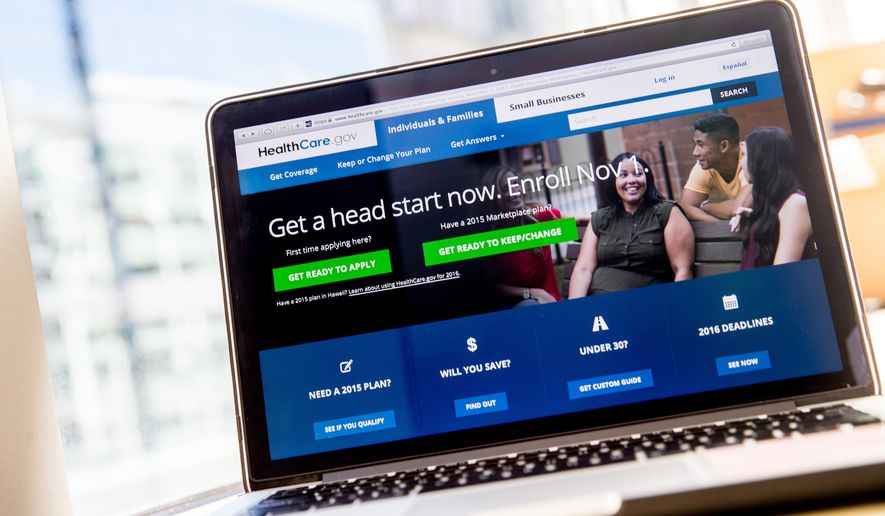New Obamacare customers are sicker and costlier than customers who bought insurance before President Obama’s massive health overhaul, one of the country’s top insurance companies said Wednesday, giving more ammunition to critics who say the law is broken.
The Blue Cross Blue Shield Association said Americans who enrolled in its Obamacare state-level exchange plans in 2014 and 2015, after the health law was fully up and running, had higher rates of diabetes, HIV and other diseases, and visited emergency rooms more frequently than pre-Obamacare enrollees and those who got coverage through their jobs.
The new customers also cost an average of 19 percent more than those with employer-based insurance in 2014 and 22 percent more in 2015, Blue Cross said, undercutting the chief argument Mr. Obama used to sell his plan to the country in 2009 and 2010.
The Health and Human Services Department said Blue Cross’ methodology was “seriously flawed” because it makes bogus comparisons between different pools of customers.
HHS officials said analysts had always expected an initial run by sicker people eager to get medical treatment, which explains the surge in costlier customers. The Obama administration said that’s why the Affordable Care Act built in transition programs to assume some of the risks in the law’s initial years.
“After years of being discriminated against, Americans with pre-existing conditions are no longer locked out of coverage because of a health condition like asthma or diabetes,” HHS spokesman Benjamin Wakana said Wednesday. “It’s no surprise that people who newly gained access to coverage under the Affordable Care Act needed health care; that’s why they were locked out of coverage before.”
The administration has said it’s working to try to entice healthier customers to sign up for Obamacare. That would keep premiums in check, while clamping down on special enrollment periods that tend to draw higher-cost customers into the exchanges.
But the higher rate of ER visits Blue Cross found is difficult to reconcile with Obamacare’s goals.
The law’s advocates had said the law was designed in part to get customers signed up with regular doctors, so they could catch problems earlier and reduce the need for costly emergency room visits.
Blue Cross urged brand-new customers to try to avoid unnecessary ER visits, and to follow their prescriptions and make regular visits to a primary care doctor.
“The findings underscore the need for all of us in the health care system, and newly insured consumers, to work together to make sure that people get the right health care service in the right care setting and at the right time,” said Alissa Fox, a Blue Cross Blue Shield senior vice president.
The findings are noteworthy because Blue Cross plans serve millions on the Obamacare’s Web-based exchanges in 46 states and D.C.
Insurer complaints
And they echo complaints from other top insurers such as UnitedHealth Group, which said it is hemorrhaging money on the exchanges due to a much sicker-than-expected customer base.
UnitedHealth has warned it might pull out of the Obamacare marketplace by 2017 if things don’t improve, though other plans have said they plan to stick it out and see if the market stabilizes.
In Blue Cross’s data, Obamacare-era enrollees filled 35 percent more prescriptions in 2015 than pre-reform individuals, and 6 percent more than members covered under their employers’ plans.
In-patient hospital admission rates among newer enrollees were 38 percent higher compared to pre-reform enrollees and 23 percent higher than employer-insured members.
Obamacare requires almost all Americans to obtain health insurance or pay a penalty, a lever designed to balance out the influx of sicker patients who cannot be denied coverage with the law’s passage.
The $695 baseline tax for 2016 was phased in from $95 in 2014 and $325 in 2015, and analysts say it might not have had enough bite to prod healthier people into the exchanges in the early rounds.
Congressional Republicans seeking to repeal and replace the law with a GOP president in 2017 argue the law is “stalling out” because coverage on the federal HealthCare.gov website and exchanges run by 12 states and D.C. is unaffordable.
The House Ways and Means Committee on Wednesday said that’s why the administration keeps shifting its expectations for enrollment.
It hoped to have 9.1 million paying customers by the end of 2015, but earlier this month it said it fell short of that goal by about 300,000, due to excess attrition.
The administration hopes to retain about 10 million of the 12.7 million customers the exchanges brought in for 2016, yet that is less than half of what congressional budget scorekeepers initially predicted.
HHS officials argue that the initial projections were based on faulty assumptions about the employer-based insurance market, while House Republicans contend that exchange plans “are just not worth the high cost.”
“Americans want affordable, high–quality health care coverage,” the Ways and Means Committee said, “not the government-mandated expensive plans, limited choices and lower-quality coverage that come with Obamacare.”
• Tom Howell Jr. can be reached at thowell@washingtontimes.com.




Please read our comment policy before commenting.